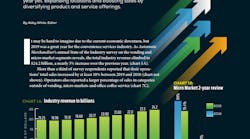State of the Industry for Vending and Micro Market Report: 2022 was a year of continued recovery
As the convenience services industry continues to make a comeback — with workers returning to the office and a boost in workplace refreshments — vending and micro market sales also climbed in 2022 with a 12% increase over the previous year’s revenue.
USEFUL LINKS
The 2022 Automatic Merchandiser State of the Industry report is featured in the 2023 June/July issue.
Click here to view a PDF of the report.
Sales in the unattended retail channel totaled $21.7 billion in 2022, compared with $19.4 billion in 2021, which was a year of rapid recovery since 2020, the first year of the COVID-19 pandemic when vending and workplace refreshments took its biggest hit due to months-long lockdowns.
While the vending industry’s revenue was expected to return to pre-pandemic levels, 2022 shows a steady pace of recovery, representing almost 89% of 2019’s benchmark revenue high of $22.2 billion, after falling 45% in 2020.
For 2022, sales remained $2.5 billion below 2019’s pre-COVID mark. But vending and micro market operators have found ways to better adapt to the challenges of rising inflation and supply chain disruptions, as well as the trend of hybrid work — a blended, post-pandemic model of in-office and remote workers. Operators looked for solutions and partnerships with business owners with the goal of attracting employees and giving them reasons to want to come into the office.
Pairing new ideas to meet customer demands with continued price increases offered some relief, but operators still felt the impact of labor shortages and lingering supply chain problems in the vending and micro market segment – continuing to struggle to procure common confections and beverage products that were once abundant.
However, 2022’s low unemployment rate in the U.S. signals room for at-work employee population growth in the coming years.
Product categories
Because vending and micro market operators provide reliable services to workplaces, product categories showed another year of improvements in 2022.
Combined vending machine and micro market revenue gains were:
- Healthy items (including plant-based) up 40%.
- Food (sandwiches, salads, entrées) up 35%.
- Snacks (salted, bars, mixes, etc.) up 27%.
- Packaged cold drinks up 15%.
- Candy (chocolate and non-chocolate) up 14%.
- Confections (pastries, cookies, etc.) up 14%.
- Ice cream/frozen items up 25%.
- Hot drinks (vended coffee, tea, cocoa, etc.) up 9%.
- Miscellaneous (other) items up 7%.
Packaged cold beverages continued to hold the highest rank among the convenience product categories last year, generating 23% of revenue, or $4.1 billion.
Dynamic categories including packaged snacks, confections and candy jointly constituted the largest market share of convenience service. In 2022, items in these categories led the way in dollar volume, representing 41.5% of all sales through vending machines and 36.5% of all sales in micro markets, or $5.5 billion and $1.5 billion, respectively.
For the healthy product category including plant-based products, sales in the combined vended and micro market segment increased from $1.8 billion to $2 billion.
Ice cream and frozen products also saw an increase in 2022, from $0.3 billion to $0.6 billion in revenue for combined vended and micro market segments.
From vending to micro markets
Last year, U.S. operators had an estimated 2.05 million vending machines on location, an increase of 4.5% from 2021. Operators shared that some of their vending locations were converted to micro markets during 2022 due to more office re-openings. This shift can be seen in the growth of estimated active micro market locations in 2022 to 30,385, up 18% compared with 25,750 installed markets the prior year.
Manufacturing locations increased 7.5% from the previous year, and office locations increased 4.5%. Micro market locations at hotel/motels also jumped in 2022. Manufacturing and office locations combined continue to represent more than half of the convenience services demographic.
A shift to smaller micro markets was also evident in 2022, with an increase in the number of micro markets placed in locations with 100 or fewer employees.
Operation snapshot
Most of this year’s survey participants defined their businesses as full-line operations providing vending machines, micro markets and office coffee service. About 5% were traditional full-line vending operations without micro markets, while about 8% operate micro markets only. About 11% said they were bottlers. Most of this year’s survey participants (74%) said they operated between one and 10 routes.
Almost half of all operators were involved in acquiring or divesting routes or parts of their operation. And most vendors said their cold drink machines, ranging from between 5% and 100%, were supplied by a bottler.
About 74% of operators said the number of combined vending and micro market locations they served in 2022 increased.
Solutions in technology
Nearly 80% of operators are embracing technology for vending and micro markets. Almost 80% said cashless payment devices are a great investment; 62% and 53% said prekitting and vending management systems, respectively, said they are also great investments. The number of operators who use a VMS increased from 61.5% last year to 77% in 2022. More operators are also using solutions for remote data collection (47%).
Operators said they were able to streamline their business better with the use of technology, contributing to the growth of their 2022 sales.
Looking beyond the pandemic, vending and micro market operators have found ways to restructure their operations to adapt to ever-changing market conditions and workplace environments and will continue to do so. Embracing new tools that help meet their customers’ demands, streamline operations and set themselves apart from the competition by bringing more value all contribute to the continued recovery for the convenience services industry.
About this study (methodology)
Data in Automatic Merchandiser’s State of the Industry report are compiled from a survey sent to operators in the spring. It collects responses from vending and micro market providers, as well as snack and soda operations. The State of the Industry report looks at performance results in major product categories.■

Molly Rogers
Molly Rogers is the former editor-in-chief of Automatic Merchandiser and VendingMarketWatch.com. She has more than 20 years of experience in custom publishing, B2B and B2C magazines, as well as advertising and marketing. She served readers by covering the latest news in the vending, office coffee service and micro market industry and helping companies connect to their audiences through strong editorial solutions.
To reach the editor of Automatic Merchandiser and VendingMarketWatch.com, email [email protected].








